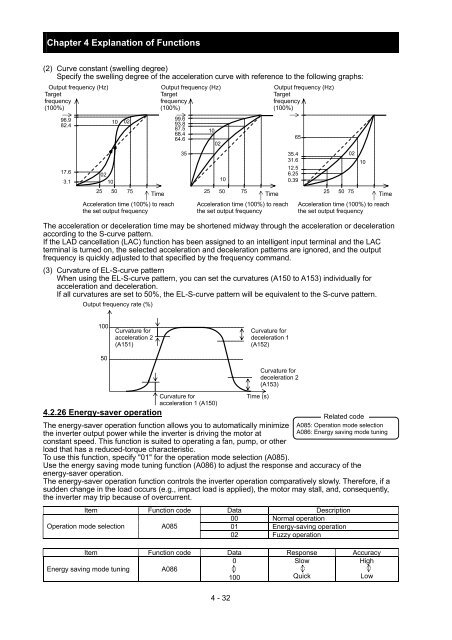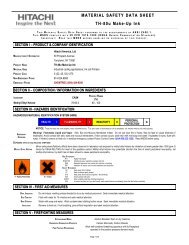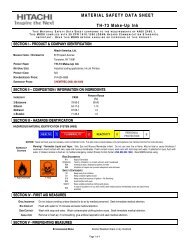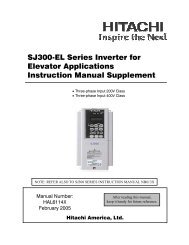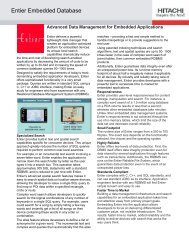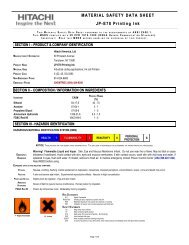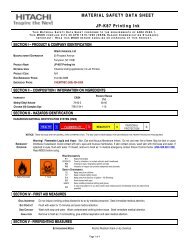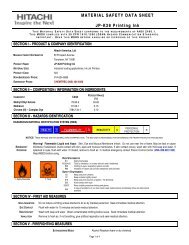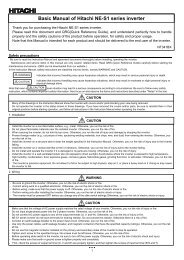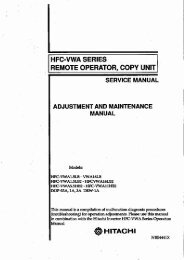SJ700-2 Instruction Manual NT204DX - Hitachi America, Ltd.
SJ700-2 Instruction Manual NT204DX - Hitachi America, Ltd.
SJ700-2 Instruction Manual NT204DX - Hitachi America, Ltd.
You also want an ePaper? Increase the reach of your titles
YUMPU automatically turns print PDFs into web optimized ePapers that Google loves.
Chapter 4 Explanation of Functions<br />
(2) Curve constant (swelling degree)<br />
Specify the swelling degree of the acceleration curve with reference to the following graphs:<br />
Output frequency (Hz) Output frequency (Hz) Output frequency (Hz)<br />
Target<br />
frequency<br />
(100%)<br />
Target<br />
frequency<br />
(100%)<br />
Target<br />
frequency<br />
(100%)<br />
96.9<br />
82.4<br />
17.6<br />
3.1<br />
10 02<br />
02<br />
10<br />
25 50 75<br />
Acceleration time (100%) to reach<br />
the set output frequency<br />
99.6<br />
93.8<br />
87.5 10<br />
68.4<br />
64.6 65<br />
02<br />
35<br />
25 50 75<br />
25 50 75<br />
Time Time Time<br />
The acceleration or deceleration time may be shortened midway through the acceleration or deceleration<br />
according to the S-curve pattern.<br />
If the LAD cancellation (LAC) function has been assigned to an intelligent input terminal and the LAC<br />
terminal is turned on, the selected acceleration and deceleration patterns are ignored, and the output<br />
frequency is quickly adjusted to that specified by the frequency command.<br />
(3) Curvature of EL-S-curve pattern<br />
When using the EL-S-curve pattern, you can set the curvatures (A150 to A153) individually for<br />
acceleration and deceleration.<br />
If all curvatures are set to 50%, the EL-S-curve pattern will be equivalent to the S-curve pattern.<br />
Output frequency rate (%)<br />
10<br />
Acceleration time (100%) to reach<br />
the set output frequency<br />
35.4<br />
31.6<br />
12.5<br />
6.25<br />
0.39<br />
02<br />
10<br />
Acceleration time (100%) to reach<br />
the set output frequency<br />
100<br />
50<br />
Curvature for<br />
acceleration 2<br />
(A151)<br />
Curvature for<br />
deceleration 1<br />
(A152)<br />
Curvature for<br />
deceleration 2<br />
(A153)<br />
4.2.26 Energy-saver operation<br />
Curvature for<br />
acceleration 1 (A150)<br />
Time (s)<br />
Related code<br />
A085: Operation mode selection<br />
A086: Energy saving mode tuning<br />
The energy-saver operation function allows you to automatically minimize<br />
the inverter output power while the inverter is driving the motor at<br />
constant speed. This function is suited to operating a fan, pump, or other<br />
load that has a reduced-torque characteristic.<br />
To use this function, specify "01" for the operation mode selection (A085).<br />
Use the energy saving mode tuning function (A086) to adjust the response and accuracy of the<br />
energy-saver operation.<br />
The energy-saver operation function controls the inverter operation comparatively slowly. Therefore, if a<br />
sudden change in the load occurs (e.g., impact load is applied), the motor may stall, and, consequently,<br />
the inverter may trip because of overcurrent.<br />
Item Function code Data Description<br />
00 Normal operation<br />
Operation mode selection<br />
A085<br />
01 Energy-saving operation<br />
02 Fuzzy operation<br />
Item Function code Data Response Accuracy<br />
Energy saving mode tuning A086<br />
0<br />
Slow<br />
High<br />
100<br />
Quick<br />
Low<br />
4 - 32


